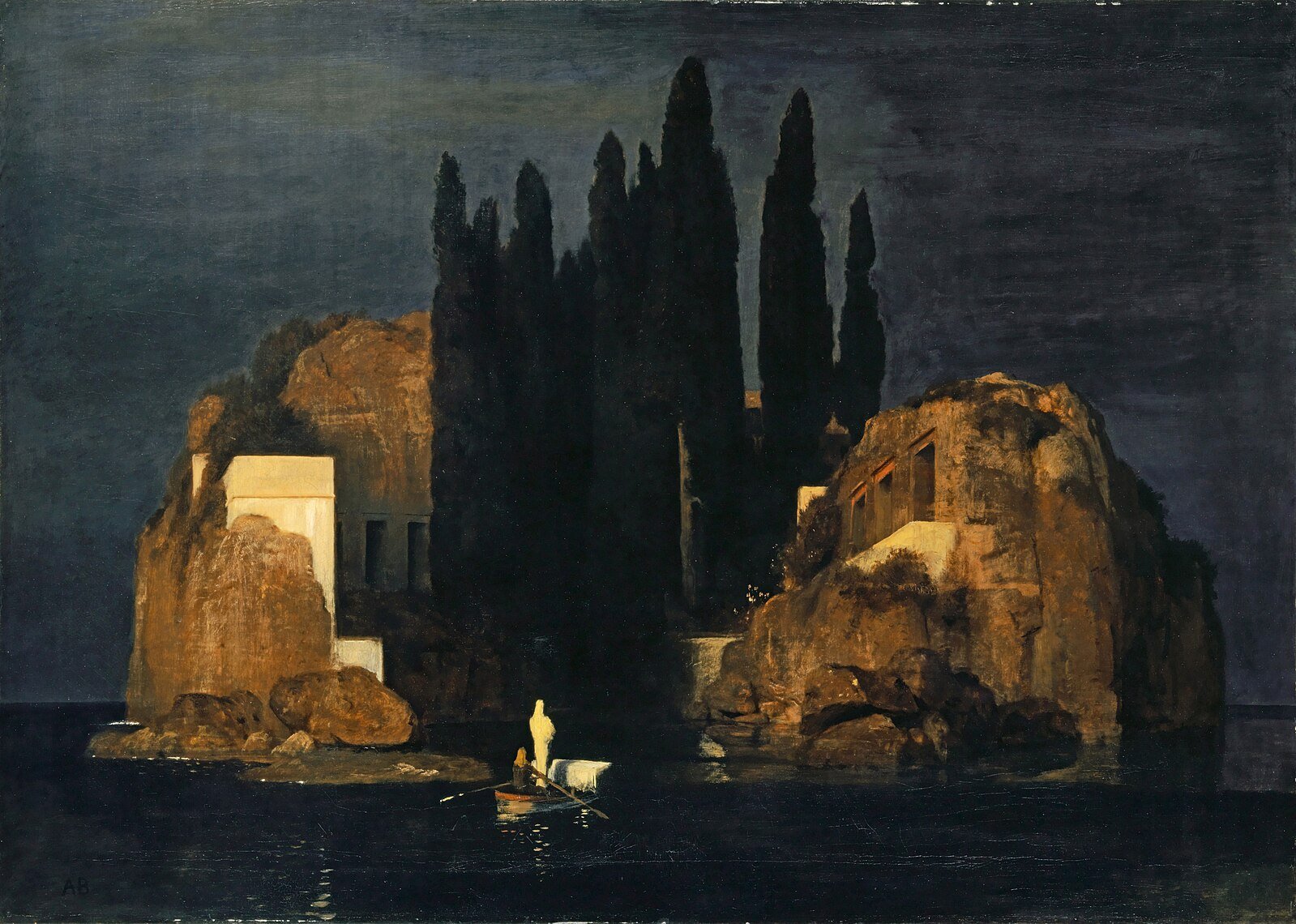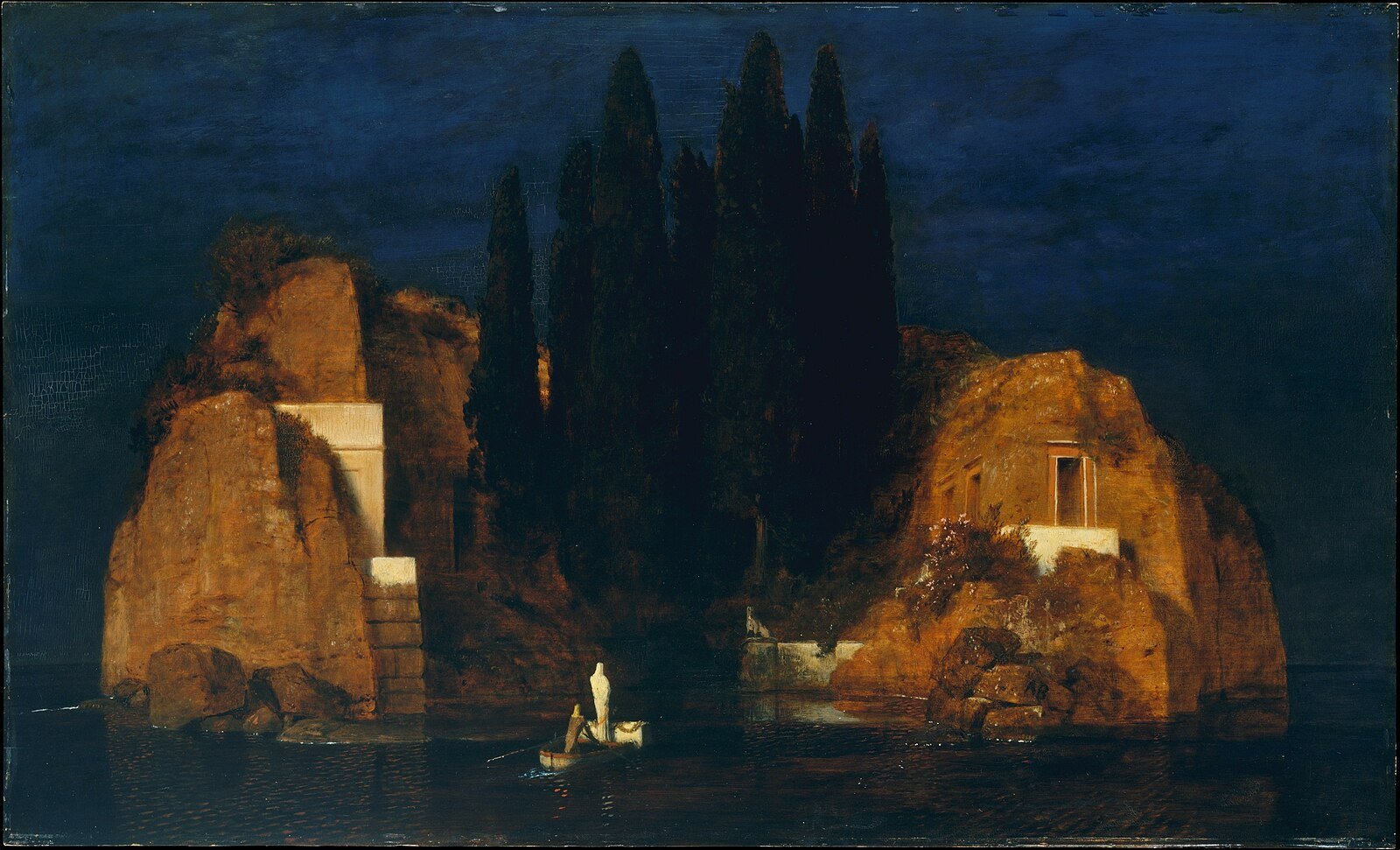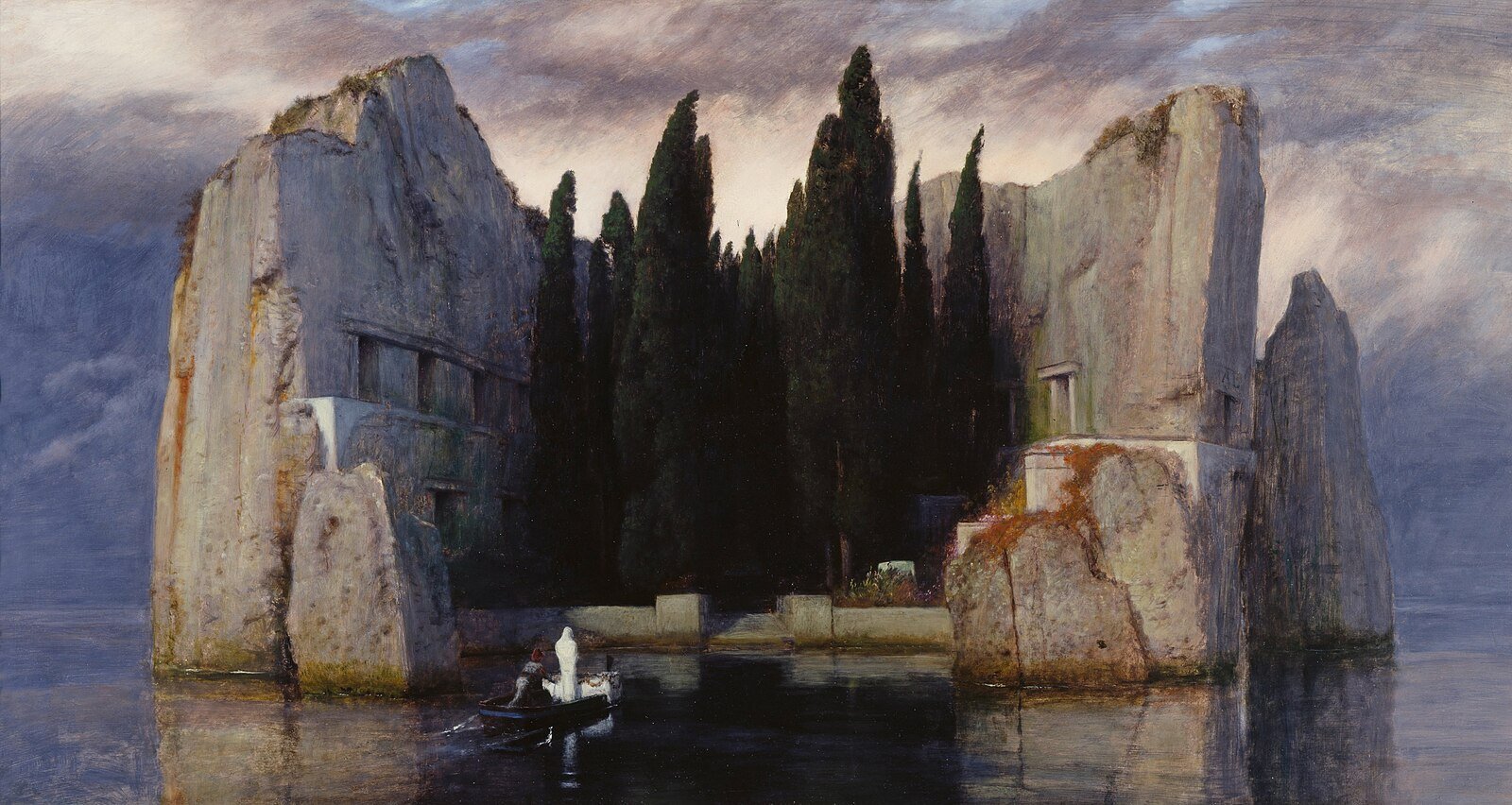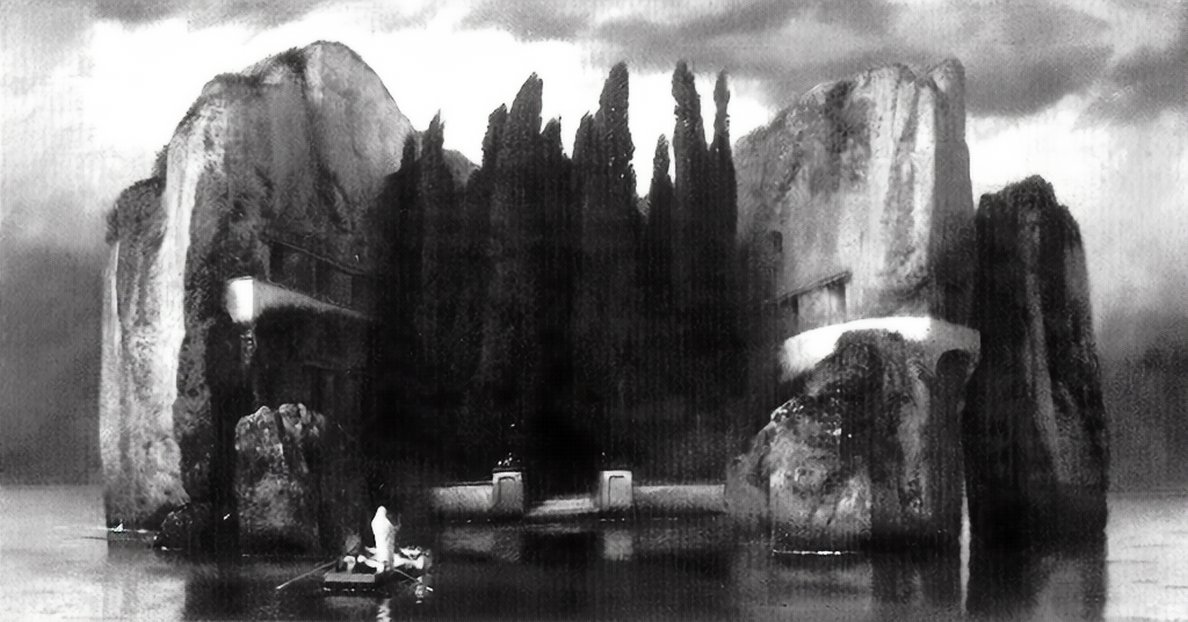Behind the Painting: Self-Portrait with Death Playing the Fiddle
Arnold Böcklin, Self-Portrait with Death Playing the Fiddle, 1872. Oil on canvas. 75 x 61 cm.
If you engage with social media platforms such as TikTok, you may have encountered Arnold Böcklin's seminal artwork, "Self-Portrait with Death Playing the Fiddle" starring in a recent trend. This painting masterfully combines elements of Romanticism with the profound symbols of the memento mori and danse macabre traditions that pervade European art. It offers a compelling exploration of mortality, artistry, and the inexorable passage of time, uniquely depicted through the interaction between the artist and a skeletal figure. The presence of death in this self-portrait invites viewers to reflect on their own lives while illustrating the timeless relevance of Böcklin’s themes.
The Painting
"Self-Portrait with Death Playing the Fiddle," painted by Arnold Böcklin in 1872, captures an intimate yet eerie tableau. The canvas is dominated by the figure of Böcklin himself, portrayed in the act of painting. He stands slightly off-center, dressed in a dark artist's smock that contrasts sharply with the lighter background. His attention is directed outward and slightly upwards, towards something beyond the viewer's sight, his expression contemplative and absorbed. In his left hand, he holds a palette brimming with vibrant colours, and his right hand wields a paintbrush. The studio around him is dimly lit, suggesting a secluded, introspective environment where the artist engages deeply with his work.
Behind Böcklin, an unsettling presence is introduced—a skeletal figure that leans over his shoulder, grinning macabrely. This figure, representing Death, is depicted in a stark, bone-white colour, creating a ghostly contrast against the darker tones of Böcklin's attire and the shadowy studio. Death holds a violin, drawing a bow across the single remaining string, its other strings conspicuously absent. The skeleton's hollow eye sockets are fixed intently on Böcklin, adding a layer of intensity to the scene. The positioning of Death, so close and personal, and the direct engagement with Böcklin, generates a palpable tension within the composition, juxtaposed with the ordinary setting of an artist's studio.
The Artist
Arnold Böcklin, Self-portrait, 1873. Oil on canvas.
Arnold Böcklin was a Swiss symbolist painter, born on October 16, 1827, in Basel, Switzerland. His career spanned much of the 19th century, a period rife with artistic experimentation and transformation in Europe. Böcklin is often categorized within the Symbolist movement, although his works frequently diverged into the realms of Romanticism and Idealism. He studied at the Düsseldorf Academy of Arts under Schirmer, a landscape painter who imparted a rigorous classical foundation. Later, Böcklin spent significant periods in Rome, which profoundly influenced his aesthetic sensibilities, immersing him in Renaissance and Baroque art. Despite these classical influences, Böcklin's artwork often ventured into more fantastical and mythological territories, creating vivid, dream-like landscapes populated by mythic creatures and eerie, supernatural elements.
Personal tragedy and loss shadowed much of Böcklin's life, deeply impacting the themes and emotional tones of his work. His first fiancée died before they could marry, a profound loss that introduced a recurring theme of death and melancholy in his paintings. Later, Böcklin married Angela Rosa Lorenza Pascucci in 1853, with whom he had fourteen children. However, the fragility of life was starkly highlighted as only nine of their children survived into adulthood. These personal experiences with death and grief imbued his art with a profound depth and complexity, often exploring themes of mortality, the afterlife, and the intersection of the human experience with the supernatural.





Böcklin's artistry was not confined to explorations of death alone; he also exhibited a keen interest in mythology and nature, frequently intertwining these elements into a narrative framework that was uniquely his own. His most famous work, "The Island of the Dead," which he painted in several versions, exemplifies his skill at merging the real with the surreal, offering viewers a glimpse into a mystical and introspective world. His works, characterized by their bold use of color and dramatic, often eerie imagery, challenged the conventional aesthetics of his time and opened up new avenues in the visual interpretation of myth and nature. Through his paintings, Böcklin sought to transcend the visible world, exploring the psychological landscapes of fear, longing, and the human psyche's confrontation with its own mortality.
Historical Context
Arnold Böcklin's "Self-Portrait with Death Playing the Fiddle" was created in 1872, a period marked by profound cultural and social changes in Europe. This era, following the upheavals of the 1848 revolutions and during the unification processes of Germany and Italy, was characterized by a mixture of optimism and anxiety about the future. The Industrial Revolution was transforming traditional lifestyles and work, pushing artists to explore themes beyond the simple reflection of reality, leading to the emergence of movements like Symbolism and Romanticism that emphasized emotions, mysticism, and the inner experiences.
Symbolism, in particular, was a reaction against the materialism and rationalism that dominated the European cultural landscape in the latter half of the 19th century. Artists like Böcklin rejected the naturalistic depictions of Impressionism, delving instead into the realm of dream, myth, and emotion to capture deeper truths. They sought to convey the unseen, the spiritual, and the subconscious, focusing on themes of mortality, existential dread, and transcendental experiences. Böcklin’s painting falls squarely within this context, blending the symbolic representation of death with personal narrative and mythical overtones to provoke reflection on life's transient nature.
The late 19th century also saw a revival of interest in medieval and early Renaissance art forms, which influenced Böcklin’s stylistic choices. His use of direct symbols such as the skeletal figure of Death and the lone violin string in "Self-Portrait with Death Playing the Fiddle" draws from earlier memento mori motifs, which served as reminders of the inevitability of death. This connection to past artistic traditions—combined with the contemporary Symbolist fascination with death and the afterlife—allowed Böcklin to explore his personal losses and his philosophical ruminations on mortality in a way that resonated with the wider societal preoccupations of his time.
Moreover, the Franco-Prussian War (1870-1871) had just concluded, leaving a backdrop of disillusionment and introspection that permeated much of European art and literature. In this atmosphere, Böcklin's exploration of death took on added resonance, serving as a conduit for public and private grief. The painting, therefore, not only reflects Böcklin’s personal meditations but also acts as a cultural mirror, reflecting broader existential anxieties of a society confronting modernity and its discontents.
Symbolism and Meaning
Arnold Böcklin's "Self-Portrait with Death Playing the Fiddle" is a rich tableau of symbolism and allegorical interpretation. The various elements in the painting encapsulate both the personal worldview of the artist and the broader thematic traditions of memento mori and vanitas. Here, we explore these symbols and their potential interpretations:
Violin with one string: this could suggest the fragility of life and the closeness of mortality, perhaps suggesting Böcklin doesn’t have much time left - or feels as though he doesnt. There are also ties to the mythological Fates who cut the thread of life, ending mortal existence.
Death Playing the Violin: motifs reflecting a dense macabre, historically used to remind viewers of the universality of death, transcending social class and status. Revisiting the Fates—Death's act of playing the violin may be interpreted as toying with mortality, playing a precarious tune on the fragile thread of life, which could snap at any moment, further highlighting the precariousness of existence.
In Company with Death: Böcklin's choice to depict himself in the company of Death may indicate a personal familiarity with his mortality, a theme underscored by the losses he experienced in his own life, including the death of his first fiancée and several of his children. This intimate portrayal of Death suggests an acceptance, if not a comfort, with its constant presence.
Artist’s Gaze & Posture: Böcklin depicts himself gazing distantly, seemingly lost in thought or perhaps listening intently to the macabre tune played by Death. This introspective pose suggests a contemplation of his own mortality. His relaxed posture, leaning slightly towards Death, indicates a certain resignation or acceptance, as if he is at peace or in deep philosophical agreement with the concept of life's fleeting nature.
Palette & Brushes: In his hand, Böcklin holds a palette and brushes, tools of his artistic trade. These items symbolize not only the artist's identity but also the creative process as a life-affirming act. They imply that through his art, Böcklin achieves a measure of immortality, preserving his thoughts, emotions, and visions beyond the confines of his physical lifespan.
Composition: The setting and composition of the painting are informal, with a dramatic contrast between the living artist and the personification of Death. This juxtaposition highlights the constant interplay between life and death, creativity and destruction, existence and non-existence.
Background: The background of the painting is dark and nondescript, which focuses attention on the figures of Böcklin and Death. This could symbolize the unknown—the mysterious and often feared nature of death and what lies beyond life.
Rumours
The narrative suggests that Böcklin added the figure of Death to his painting solely due to his friends' inquiries regarding what the subject appeared to be hearing. If this account holds true, it introduces a significant layer to the interpretation of the artwork, potentially altering its context and meaning. Typically, elements such as the inclusion of Death in a painting might be seen as a deliberate thematic choice by the artist to convey deep, personal contemplations or societal commentary. However, if the addition was a response to external suggestions rather than an intrinsic part of the artist's original vision, it could suggest a more interactive or fluid approach to the composition of the piece.
This possibility challenges the notion of the solitary genius working in isolation, instead highlighting a collaborative aspect to artistic creation, even if indirectly. It also raises questions about the authenticity of the representation of themes in art—whether they fully represent the artist's personal vision or are shaped by the perceptions and ideas of others. Furthermore, understanding that such a significant element as Death could have been an afterthought or an addition prompted by casual conversation rather than premeditated intent might shift the viewer's interpretation from one of inevitable mortality as a profound, underlying theme to one where death might be seen as just another compositional element, included for its aesthetic impact or as a nod to contemporary tastes or expectations within Böcklin's social circle. This insight could reframe the artwork from a solemn meditation on life's end to a more dynamic exploration of how art interacts with and is influenced by its social environment.
Contemporary Interpretation and Relevance
Today, "Self-Portrait with Death Playing the Fiddle" has found resonance in various cultural contexts, including as a meme on platforms like TikTok, where it is often used to represent the concept of a 'devil on the shoulder' or a 'bad influence.'
Images from @DaUndeadwarrior on TikTok, ‘Google Maps Challenge’.
This modern reinterpretation serves as a testament to the painting's versatile symbolic value and its adaptability across different mediums and audiences. The portrayal of Death in this contemporary context shifts from its original, possibly existential or introspective, significance to a more colloquial and relatable depiction of everyday moral and life choices.
In conclusion, Arnold Böcklin's "Self-Portrait with Death Playing the Fiddle" endures as a profound artistic meditation on life, death, and the creative process. The painting bridges historical art traditions such as Romanticism, memento mori, and danse macabre with contemporary resonances, particularly in the digital age where it gains new life as a meme on platforms like TikTok. By integrating timeless themes with elements that speak directly to modern viewers, Böcklin’s work transcends its nineteenth-century origins, continuing to engage and provoke audiences. The unique juxtaposition of the artist at work with the macabre figure of Death serves not only as a reflection on the inevitability of mortality but also as a reminder of the perpetual relevance and transformative power of art in human culture.



